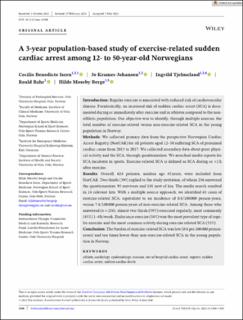| dc.contributor.author | Isern, Cecilie Benedicte | |
| dc.contributor.author | Kramer-Johansen, Jo | |
| dc.contributor.author | Bahr, Roald | |
| dc.contributor.author | Berge, Hilde Moseby | |
| dc.contributor.author | Myrhaugen, Ingvild Beathe Tjelmeland | |
| dc.date.accessioned | 2023-10-12T12:15:50Z | |
| dc.date.available | 2023-10-12T12:15:50Z | |
| dc.date.created | 2023-06-14T13:50:18Z | |
| dc.date.issued | 2023 | |
| dc.identifier.citation | Scandinavian Journal of Medicine & Science in Sports. 2023, 33(8), Side 1560-1569. | en_US |
| dc.identifier.issn | 0905-7188 | |
| dc.identifier.uri | https://hdl.handle.net/11250/3096111 | |
| dc.description | This is an open access article under the terms of the Creative Commons Attribution-NonCommercial-NoDerivs License, which permits use and distribution in any medium, provided the original work is properly cited, the use is non-commercial and no modifications or adaptations are made. | en_US |
| dc.description.abstract | Introduction: Regular exercise is associated with reduced risk of cardiovascular disease. Paradoxically, an increased risk of sudden cardiac arrest (SCA) is documented during or immediately after exercise and in athletes compared to the nonathletic population. Our objective was to identify, through multiple sources, the total number of exercise-related versus non-exercise-related SCA in the young population in Norway.
Methods: We collected primary data from the prospective Norwegian Cardiac Arrest Registry (NorCAR) for all patients aged 12–50 suffering SCA of presumed cardiac cause from 2015 to 2017. We collected secondary data about prior physical activity and the SCA, through questionnaires. We searched media reports for SCA incidents in sports. Exercise-related SCA is defined as SCA during or <1 h after exercise.
Results: Overall, 624 patients, median age 43 years, were included from NorCAR. Two thirds (393) replied to the study invitation, of whom 236 answered the questionnaires: 95 survivors and 141 next of kin. The media search resulted in 18 relevant hits. With a multiple source approach, we identified 63 cases of exercise-related SCA, equivalent to an incidence of 0.8/100 000 person-years, versus 7.8/100 000 person-years of non-exercise-related SCA. Among those who answered (n = 236), almost two thirds (59%) exercised regularly, most commonly (45%) 1–4 h/week. Endurance exercise (38%) was the most prevalent type of regular exercise and the most common activity during exercise-related SCA (53%).
Conclusion: The burden of exercise-related SCA was low (0.8 per 100 000 person-years) and ten times lower than non-exercise-related SCA in the young population in Norway. | en_US |
| dc.language.iso | eng | en_US |
| dc.subject | athlete | en_US |
| dc.subject | cardiology | en_US |
| dc.subject | epidemiology | en_US |
| dc.subject | exercise | en_US |
| dc.subject | out-of-hospital cardiac arrest | en_US |
| dc.subject | registry | en_US |
| dc.subject | sudden cardiac arrest | en_US |
| dc.subject | sudden cardiac death | en_US |
| dc.title | A 3-year population-based study of exercise-related sudden cardiac arrest among 12- to 50-year-old Norwegians | en_US |
| dc.type | Peer reviewed | en_US |
| dc.type | Journal article | en_US |
| dc.description.version | publishedVersion | en_US |
| dc.rights.holder | © 2023 The Authors | en_US |
| dc.source.pagenumber | 1560-1569 | en_US |
| dc.source.volume | 33 | en_US |
| dc.source.journal | Scandinavian Journal of Medicine & Science in Sports | en_US |
| dc.source.issue | 8 | en_US |
| dc.identifier.doi | 10.1111/sms.14400 | |
| dc.identifier.cristin | 2154512 | |
| dc.description.localcode | Institutt for idrettsmedisinske fag / Department of Sports Medicine | en_US |
| cristin.ispublished | true | |
| cristin.fulltext | original | |
| cristin.qualitycode | 1 | |
